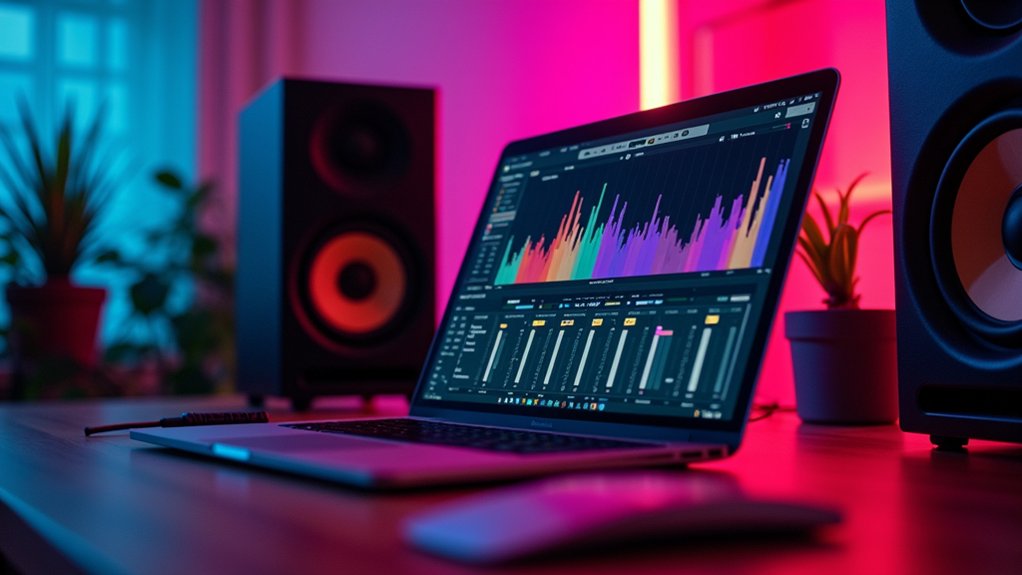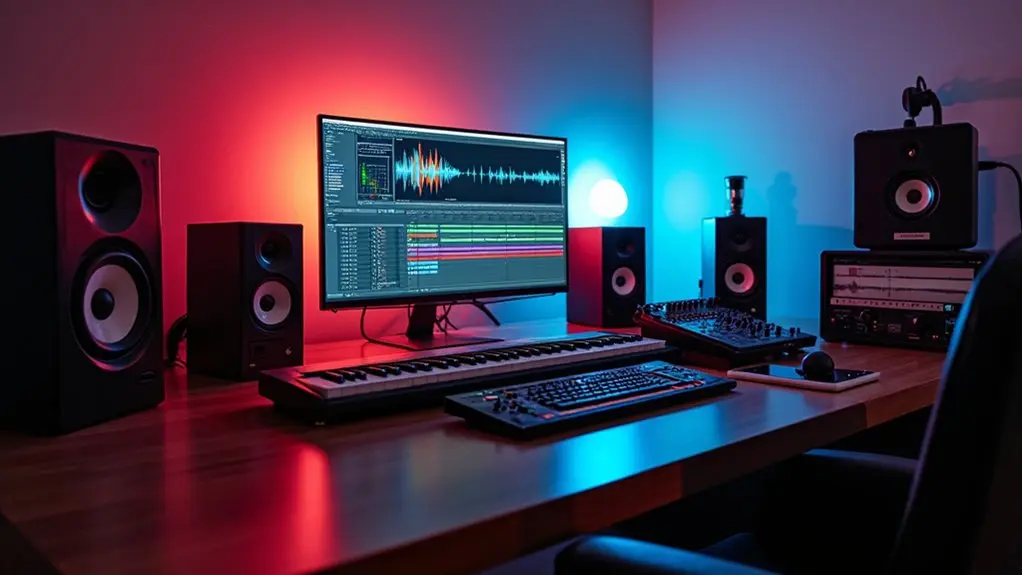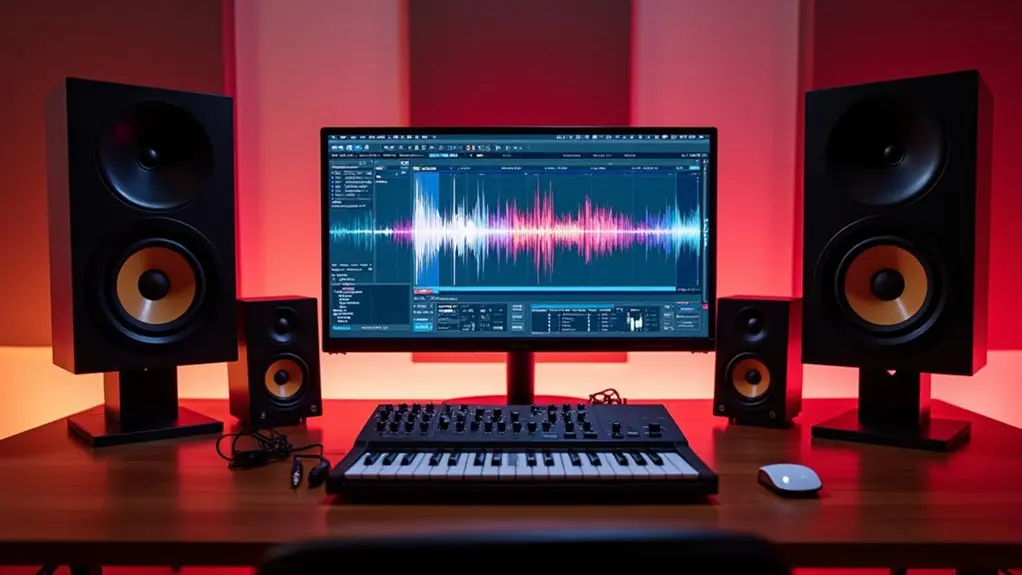Granulator II in Ableton is a granular synthesis device that fragments audio into adjustable grains, enabling independent control of size, pitch, and playback position. Users can sculpt textures using dedicated controls for grain size, spray, density, and randomization, with visual feedback for precise editing. Modulation options such as LFOs and envelopes add dynamic movement, while Freeze Mode and sample scanning facilitate live granulation and evolving pads. Further exploration reveals advanced techniques for crafting unique textures and glitch-driven soundscapes.
Key Takeaways
- Granulator II fragments audio into grains, allowing independent control of grain size, pitch, density, and playback position for unique sound design.
- Import high-quality, trimmed samples to maximize richness and variation in granular textures.
- Adjust grain size and spray controls to create anything from smooth evolving pads to glitchy, staccato effects.
- Use randomization, LFOs, and envelopes to modulate grain parameters dynamically for evolving, organic soundscapes.
- Activate Freeze mode to capture audio snapshots, enabling live performance manipulation and continuous texture evolution.
Understanding Granular Synthesis and Its Unique Sound Potential
While traditional synthesis methods rely on manipulating oscillators, filters, and envelopes, granular synthesis operates by fragmenting audio into minuscule segments known as grains, typically spanning 10 to 50 milliseconds.
Each grain can be individually modulated in parameters such as pitch, size, and playback position, enabling intricate alteration of sonic textures and temporal structure. This approach allows for advanced techniques like time-stretching and pitch-shifting without introducing conventional artifacts.
Granulator II, a granular synthesis tool in Ableton, offers precise control over grain frequency, envelope shaping, and randomness via features like “Spray.”
These controls empower sound designers to sculpt complex, evolving soundscapes—ranging from ethereal pads to glitch-based effects—by harnessing the organic unpredictability inherent in grain manipulation.
Granular synthesis consequently expands creative sound design possibilities substantially.
Exploring the Interface and Workflow of Granulator II
Building on the unique capabilities of granular synthesis, Granulator II’s interface prioritizes direct manipulation of core grain parameters, streamlining the process of sculpting complex textures and evolving timbres.
The granular interface features dedicated controls for adjusting grain size, position, and density, allowing sound designers to rapidly iterate a diverse range of sonic results. Real-time visual feedback is provided through a waveform display, where users can observe grain distribution and immediately assess parameter changes.
Playback rate, grain frequency, and randomization controls further expand the interface’s flexibility, offering nuanced control over texture and rhythmic qualities. Integrated LFO and envelope sections enable dynamic modulation, supporting movement and evolution within the granular soundscape.
The workflow is designed for intuitive exploration, with parameters logically organized for efficient access and experimentation.
Importing and Preparing Audio Samples for Granulation
Initiating the granulation process in Granulator II requires importing high-quality audio samples, either by dragging them directly into the device or selecting them through Ableton Live’s file browser.
For best sonic results, users should prioritize audio samples with rich texture and dynamic variation, as these characteristics maximize the potential for complex sonic transformations. Before importing, trimming the audio sample to highlight desired segments guarantees focus and relevance within the project context.
The selection process benefits from experimenting with diverse material—vocals, environmental recordings, or synthesized tones—to broaden the palette of possible granular textures.
After importing, the ‘File Position’ parameter in Granulator II allows precise selection of the starting point within the audio sample, granting control over which sonic elements are targeted for granulation, shaping the resulting soundscape.
Manipulating Grain Size for Texture and Rhythm
After selecting and preparing a suitable audio sample, attention turns to manipulating grain size within Granulator II. Grain size is a pivotal parameter that directly shapes the resulting texture.
Shorter grains—typically in the 10-20 millisecond range—produce glitchy, staccato effects, ideal for injecting rhythmic complexity or percussive detail. Conversely, longer grains, between 40-50 milliseconds, result in smoother, more sustained textures, suitable for crafting pads and atmospheric layers.
Adjusting grain size in real time can dynamically transform the sonic character, from tightly sequenced rhythmic fragments to lush, evolving soundscapes. Integrating the spray parameter with granular size modulation introduces organic unpredictability, further enhancing texture.
Sound designers often exploit this synergy to create intricate, evolving patterns, especially effective in ambient, experimental, and cinematic genres.
Controlling Grain Position and File Scanning
Direct manipulation of Grain Position in Granulator II grants granular control over where each grain begins within the audio sample, facilitating targeted extraction of sonic material. By precisely setting the Grain Position parameter, sound designers can isolate and emphasize specific timbral or transient elements within a sample.
Automating Grain Position further enables dynamic movement along the waveform, introducing evolving textures and rhythmic interest.
File scanning expands this approach by continuously shifting the Grain Position during playback, allowing for seamless traversal through the sample. This technique is essential for creating organic, morphing soundscapes.
Incorporating the Spray function injects randomness into the starting points of grains, resulting in less predictable, more natural sonic variations.
Combining controlled Grain Position with file scanning and subsequent filtering or envelope shaping enhances timbral richness and smoothness in complex patches.
Harnessing Pitch and Time Manipulation in Granulator II
Granulator II empowers sound designers with precise pitch and time manipulation at the granular level, enabling sophisticated control over sonic transformation.
Pitch manipulation in Granulator II allows independent adjustment of each grain’s pitch, facilitating the creation of harmonically dense textures or experimental, dissonant layers by shifting grains up or down.
Time manipulation is addressed via grain size and rate parameters, effectively stretching or compressing audio while preserving fidelity. This enables the generation of lush, ambient pads or sharp, glitch-based effects.
By combining pitch and time manipulation, users can craft complex, evolving soundscapes where grains interact at varying pitches and temporal intervals.
Envelope controls further refine the sonic outcome, shaping the amplitude response and dynamically influencing the interplay between pitch and time transformations.
Using Randomization and Spray for Organic Movement
In Granulator II, the Spray parameter introduces unpredictable grain placement by randomizing the File Position, which results in a more natural and evolving sound.
This approach enhances textural complexity, as each trigger produces subtle variations that enrich the overall timbre.
Embracing Unpredictable Grain Placement
When unpredictable grain placement is incorporated through the Spray parameter in Granulator II, sound designers gain nuanced control over the spatial and temporal distribution of grains within a sample.
Activating and adjusting the Spray control introduces randomization, dispersing grain onset points across the waveform rather than anchoring them to fixed positions. This stochastic process results in a more organic and evolving sonic character, particularly effective when combined with varied grain sizes.
Larger grain sizes yield smoother, more blended textures, while increased randomization mitigates phase coherence and repetition artifacts. The resulting soundscape mimics natural acoustic irregularities, transforming static samples into expressive, dynamic audio.
This workflow is advantageous for both ambient sound design and live performance, where unpredictability enhances realism and creative flexibility.
Enhancing Textural Complexity
Utilizing randomization through the Spray parameter introduces nuanced modulation to the File Position, enabling intricate variation in grain onset and distribution. In the context of granular synthesis with Granulator II, this workflow is essential for enhancing textural complexity. Adjusting the Spray control diversifies the temporal placement of grains, yielding organic, less predictable sonic results. This randomness simulates natural movement, moving beyond static, loop-based textures to dynamic, evolving layers. By integrating randomization with other synthesis parameters—such as grain size and playback rate—sound designers can sculpt rich, multi-dimensional textures suitable for experimental and ambient genres.
| Parameter | Effect on Synthesis | Resulting Texture |
|---|---|---|
| Spray Amount | Grain File Position Spread | Organic, shifting layers |
| Grain Size | Duration of Grains | Smooth vs. choppy textures |
| Playback Rate | Speed/Pitch Variation | Dense or sparse complexity |
Achieving Evolving Soundscapes
How does one foster truly organic movement within granular synthesis? In Granulator II, the Spray parameter is essential for introducing randomized grain positions, resulting in granular, evolving soundscapes with natural fluctuation.
Short grain sizes paired with high Spray values yield glitch-driven, unpredictable artifacts, whereas extending grain duration and moderating Spray produces lush, evolving pads.
Dynamic automation of the Rate parameter modulates grain density, supporting fluid shifts between dense textures and open, sparse atmospheres.
Utilizing the Randomization feature further diversifies pitch and grain size, ensuring each iteration offers unique sonic characteristics.
Engaging Freeze mode captures audio snapshots, which, when manipulated with randomization, generate evolving layers with continuous motion.
This workflow empowers sound designers to create organic, ever-changing granular soundscapes that maintain listener engagement throughout a composition.
Applying Envelopes, LFOs, and Dynamic Modulation
A wide range of modulation options in Granulator II enables precise control over granular synthesis parameters, markedly expanding creative potential for sound designers.
Envelopes in Granulator II allow for detailed shaping of grain amplitude and dynamics by manipulating attack, decay, sustain, and release stages. These envelope settings facilitate smooth changes or sharper contours within the granular texture.
The dedicated LFOs section offers time-based modulation of critical parameters such as grain size and pitch, introducing evolving motion or rhythmic pulsations into the sound. By fine-tuning LFO rate and depth, users can impart complex movement and unpredictability to the grains.
Combining envelope shapes with LFO modulation results in intricate, expressive sound design—enabling both subtle morphing textures and pronounced dynamic shifts, all controllable via real-time macro assignments.
Creative Applications: Pads, Glitch FX, and Soundscapes
Granular synthesis-based workflows in Granulator II enable the construction of diverse sonic textures, ranging from lush ambient pads to intricate glitch effects and immersive soundscapes. By extending grain size and utilizing overlapping envelopes, sound designers can craft ethereal pads and evolving soundscapes with seamless changes. For glitch FX, using shorter grains and increasing Spray introduces randomness, resulting in unpredictable sonic artifacts. Independent pitch and time manipulation further enhances the morphing capabilities of soundscapes. Automation of parameters such as grain size, position, and rate injects dynamic changes, essential for expressive live performance and nuanced studio production. Integrating FabFilter Pro-Q 3 into your workflow allows for precise frequency adjustments, enhancing the clarity and depth of these sonic textures.
| Application | Key Parameter | Sonic Result |
|---|---|---|
| Pads | Long Grain Size | Smooth, evolving pads |
| Glitch FX | Spray/Short Grain | Erratic, glitchy FX |
| Soundscapes | Pitch/Time Shift | Morphing textures |
Leveraging Freeze Mode and Real-Time Performance Tools
Releasing advanced sound design workflows, Freeze mode in Granulator II captures transient audio segments for immediate manipulation, facilitating the creation of evolving textures during live sets.
This feature integrates seamlessly into real-time performance, enabling users to instantly sample, lock, and reprocess audio without disrupting the performance flow.
Utilizing the LFO and envelope sections, performers can impart intricate modulation to the frozen grains, introducing dynamic movement and expressiveness.
Automation of Freeze mode parameters combined with randomization and probability controls results in complex, unpredictable sonic environments ideal for improvisational contexts.
- Capture and hold transient audio for live manipulation using Freeze mode.
- Modulate frozen samples with LFOs and envelopes for dynamic, evolving sound.
- Employ randomization and probability to introduce unpredictability in real-time performance.
Essential Tips for Effective Granular Sound Design in Ableton
Building on advanced performance techniques such as Freeze mode and real-time modulation, effective granular sound design in Ableton hinges on understanding the influence of source material and parameter control.
High-quality audio samples serve as the foundation for compelling granular textures, as the spectral content of the original recording impacts the resulting timbres. Manipulating grain size and position is essential—short grains can introduce rhythmic glitches, while extended grains facilitate lush, ambient pads.
The Spray parameter’s randomization features inject organic movement and unpredictability into the sound design process. Automation of key parameters like grain frequency and position yields evolving, dynamic textures.
Utilizing Freeze mode enables precise capture and manipulation of transient audio moments, expanding both performance and sound design possibilities within Ableton’s granular synthesis environment.
By arming the track for recording, users can effectively capture and resample audio, enriching their granular synthesis projects with uniquely crafted soundscapes.
Frequently Asked Questions
Does Ableton Have a Granulator?
Ableton Live offers built-in granular effects for advanced sound manipulation. Users can employ granular synthesis techniques to deconstruct audio samples, control grain parameters, and modulate textures, supporting intricate sound design workflows and real-time creative experimentation with audio material.
Is Granulator 2 Free?
Granulator II is not free; it is a paid device requiring an Ableton Live license. While its advanced Granulator features enhance granular synthesis workflows, users seeking Granulator alternatives may explore free tools within Ableton’s stock devices or community resources.
How to Granular Synthesis in Ableton?
To perform granular synthesis in Ableton, users import an audio sample, then apply granular techniques such as adjusting grain size, file position, and spray. This workflow enables advanced sound manipulation, allowing intricate transformations and creative sound design possibilities.
Where to Find Granulator 3 in Ableton?
The current question addresses locating “Granulator 3” in Ableton for granular effects and synthesis techniques. However, Granulator 3 does not exist; users should utilize Granulator II, accessible via the Max for Live Instruments workflow.
Conclusion
Granulator II offers a versatile, workflow-efficient approach to granular synthesis within Ableton Live, empowering sound designers to sculpt intricate textures, evolving pads, and experimental effects. By mastering grain size, position, and modulation sources such as envelopes and LFOs, users access a wide sonic palette. Integrating Freeze and real-time performance tools further expands creative potential. Ultimately, Granulator II stands as an essential instrument for those seeking advanced, hands-on granular manipulation and innovative sound design possibilities in a DAW environment.




